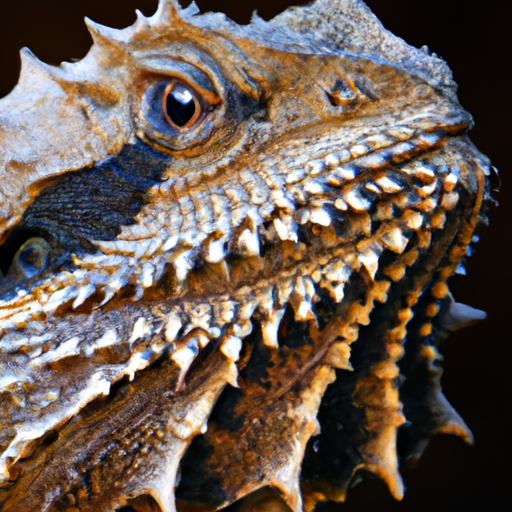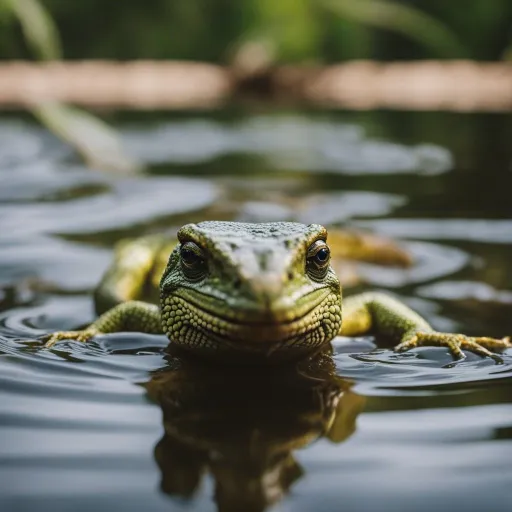Curious about whether frilled lizards are venomous? This article will put your curiosity to rest as it explores the question of whether these fascinating creatures possess venom.
With their unique appearance and impressive defensive behaviors, frilled lizards have intrigued both researchers and reptile enthusiasts.
Let’s uncover the truth about whether these reptiles pack a venomous punch or rely solely on their striking frills to deter threats.

Introduction to frilled lizards
Have you ever wondered if frilled lizards are venomous? These unique reptiles are known for their distinctive frills and incredible defensive displays.
Found primarily in northern Australia and southern New Guinea, frilled lizards belong to the family Agamidae. Also known as “frill-necked lizards” or “frilled dragons,” these fascinating creatures have captured the curiosity of many with their remarkable physical characteristics and behavior.
In this article, we will delve into the world of frilled lizards, exploring their physical appearance, habitat, diet, defensive behavior, and the controversial topic of their venomous reputation.
Physical characteristics of frilled lizards
Frilled lizards are instantly recognizable due to their impressive frills, which are large, pleated extensions of skin that surround their heads and necks.
When threatened or during courtship rituals, these frills can be unfurled to create an intimidating display that aims to startle predators or attract potential mates.
The frills are supported by elongated cartilage rods, which allow the lizards to increase the frill’s surface area dramatically.
Beyond their frills, frilled lizards have slender bodies and can grow to be around 2 feet in length, including their long tails.
Their limbs are well-adapted for climbing trees, with sharp, curved claws that enable them to skillfully navigate their arboreal habitats.
Frilled lizards have a unique coloration, typically consisting of a combination of brown, green, and yellow hues.
This camouflage helps them blend seamlessly into their lush surroundings, making it easier for them to remain undetected by potential threats.
Behavior and habitat
Frilled lizards are primarily arboreal creatures, spending much of their time in trees. Their natural habitat includes tropical forests and woodland areas that provide an abundance of prey and suitable hiding spots.
These lizards are agile climbers, capable of swiftly moving among branches and using their tails to maintain balance.
When threatened or disturbed, frilled lizards often drop from trees and glide to the ground, utilizing an impressive membrane of skin called a patagium that stretches between their limbs.
Despite their arboreal lifestyle, frilled lizards do descend to the ground occasionally. This usually happens when they need to forage for food or when it’s time to lay eggs.
Although they are predominantly active during the day, these lizards are known to bask in the sun during cooler mornings and late afternoons, helping regulate their body temperature.
As solitary creatures, interactions between frilled lizards are generally limited to mating or territorial disputes.
Frilled lizards’ diet
Frilled lizards are carnivorous, feeding primarily on insects such as ants, termites, beetles, and grasshoppers.
Due to their exceptional climbing abilities, they can snatch their prey from trees or pounce on it while on the ground.
Their long, sticky tongues allow them to catch fast-moving insects with impressive accuracy. Frilled lizards have been observed to exhibit a sit-and-wait hunting strategy, remaining motionless until prey comes within striking distance.
While insects form the majority of their diet, frilled lizards are opportunistic predators and may consume small invertebrates, reptiles, and even small mammals if given the chance.
However, their main energy source comes from the abundant array of insects available in their natural habitat. As efficient hunters, their diet plays an essential role in sustaining their active lifestyles.

Defensive behavior of frilled lizards
When it comes to defending themselves, frilled lizards possess an extraordinary ability to intimidate potential threats.
At the first sign of danger, they will open their mouths wide, displaying their bright pink or yellow oral cavity.
Simultaneously, they rapidly unfurl their frills, creating a large, intimidating “collar” that surrounds their heads.
This sudden display of aggression is often enough to ward off predators, as the frilled lizard appears much larger and more menacing than its actual size.
Additionally, the frill’s bright colors can confuse or startle predators, buying the lizard valuable time to escape.
If retreating isn’t an option, frilled lizards will rear up on their hind legs, standing tall and using their tails for balance, creating an even more imposing posture.
Frilled lizards’ venomous reputation
One of the most controversial aspects of frilled lizards is their rumored venomous nature. Over the years, these reptiles have gained a reputation for being venomous, often causing confusion among enthusiasts and researchers alike.
However, the truth behind the frilled lizards’ venomous capabilities is far from straightforward.
Understanding frilled lizards’ venom glands
While frilled lizards possess venom glands, as do other members of the Agamidae family, the potency and purpose of their venom remain uncertain.
Studies suggest that the venom glands in frilled lizards produce a mild venom, potentially used to incapacitate or subdue prey.
However, no confirmed cases of frilled lizards causing harm to humans have been reported, suggesting that their venom poses little to no threat to human beings.
Venomous effects on prey
If the venom of frilled lizards is primarily used to immobilize or neutralize their prey, it likely contains enzymes or toxins that affect the nervous system of their victims.
Upon injecting venom, frilled lizards would paralyze or weaken their prey, making it easier to consume.
However, further scientific research is needed to gain a comprehensive understanding of frilled lizards’ venom and its effects on different prey species.
Can frilled lizards harm humans?
While frilled lizards have venom glands, their venom has not been shown to pose a significant threat to humans.
As mentioned earlier, no confirmed cases of frilled lizards causing harm to humans exist. These reptiles typically avoid interaction with larger animals, and their defensive behavior and venom are more geared towards deterring potential predators and capturing prey.
It is important to note that frilled lizards, like many wild animals, should be treated with respect and observed from a safe distance.
While they may appear fascinating and relatively harmless, it is still crucial to appreciate their natural behavior and maintain a safe environment for both humans and these extraordinary creatures.
Final Thoughts
In conclusion, frilled lizards are remarkable reptiles with unique physical characteristics and captivating behavior.
Their frills, used for both defensive displays and courtship rituals, make these lizards truly distinctive and memorable.
While rumors of their venomous nature persist, frilled lizards are not considered a direct threat to humans.
Their venom, if present, is mild and primarily designed to incapacitate their prey. Appreciating their beauty and observing them in their natural habitat is a privilege that allows us to better understand and respect the diverse world of reptiles.




